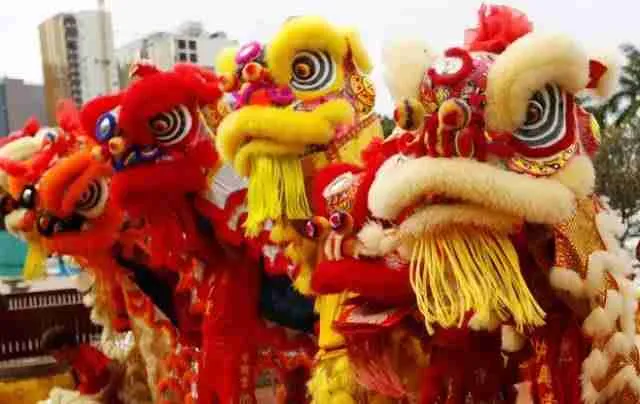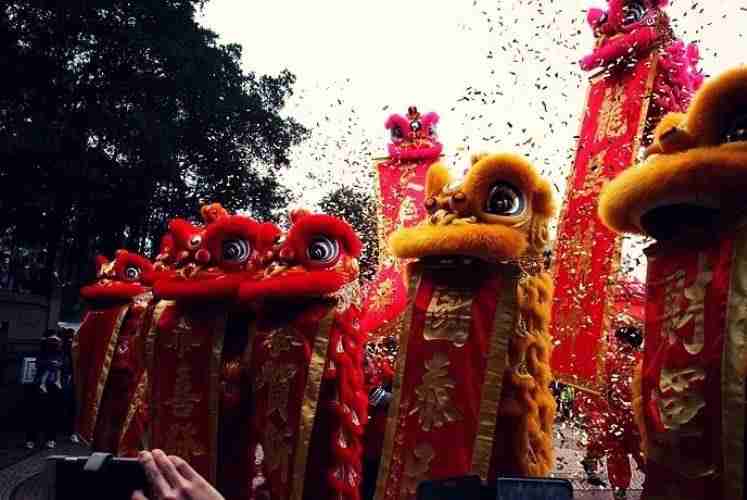The New Year lion dance is a highly ancient and symbolically rich performance form within Chinese traditional culture. Originating from ancient times, this tradition has evolved and perfected over centuries. The lion dance aims to ward off evil, bring good luck and prosperity, becoming a significant celebration during the New Year.
During the Spring Festival, people perform lion dances in public spaces, temples, and homes. A typical lion dance troupe consists of two performers, one portraying the lion’s head and the other the lion’s body. In the performance, the lion exhibits various movements such as jumping, rolling, and head shaking to showcase the lion’s majesty and strength. These actions carry specific meanings; for instance, the lion’s high jumps symbolize the potential for progress in family and career.
The lion dance is accompanied by rhythmic music played on instruments like drums and gongs, creating a lively and festive atmosphere. The rhythm and sounds of the drums and gongs are believed to dispel evil and bring good luck. After the performance, the lion may parade through neighborhoods, symbolizing the spreading of good fortune and prosperity to every household.
Beyond China, the lion dance tradition has also gained popularity in other Asian countries and regions such as Vietnam, Thailand, Indonesia, and more. This tradition has become a vital medium for cross-cultural exchange, allowing people from different countries and regions to share and experience the charm of Chinese culture together.
The meaning of lion dance
Lion dance is a traditional Chinese cultural performance and a common celebration during the New Year. The lion dance symbolizes auspiciousness, good luck, prosperity, and unity, closely related to traditional Chinese culture and folk beliefs.

Firstly, the lion dance symbolizes auspiciousness and peace. In traditional culture, lions represent bravery and strength, capable of warding off evil and ensuring safety. People perform lion dances during the New Year, hoping for a smooth and peaceful year ahead, wishing for the well-being of their families. This symbolism originates from ancient reverence for natural forces and fear of the unknown, gradually evolving into a custom of blessings and celebration.
Secondly, the lion dance signifies good luck and wealth. Lions are regarded as symbols of nobility and prestige in Chinese traditional culture, representing power and status. Therefore, people believe that the lion dance can bring good luck and prosperity. During the New Year, people perform lion dances to pray for good fortune and wealth, aspiring for a successful career and financial prosperity. This symbolism reflects people’s pursuit and yearning for a better life.
Thirdly, the lion dance symbolizes a bountiful harvest. In agrarian societies, a plentiful harvest was a paramount concern. The lion dance, embodying bravery and strength, also signifies the power and abundance in agricultural production. People believe that performing the lion dance during the New Year can bring a good harvest and prosperity. This symbolism expresses people’s anticipation and desire for a fruitful harvest.
Fourthly, the lion dance signifies unity and friendship. During the New Year, lion dance performances are typically organized by communities or groups, requiring collaboration from multiple individuals. This collective activity helps strengthen unity and a spirit of cooperation within the community. Through participating together in lion dance performances, people can enhance their connections and friendships, celebrating the arrival of the New Year collectively. This symbolism reflects the traditional Chinese cultural values of collectivism and social harmony.
Additionally, the lion dance holds significance in preserving and passing down artistic and cultural heritage. As a traditional performing art form, the lion dance integrates various elements such as music, dance, and acrobatics, constituting an essential part of Chinese culture. By inheriting and developing the art of lion dance, people can promote outstanding traditional Chinese culture, fostering a sense of national identity and cultural confidence. Simultaneously, lion dance performances serve as a bridge for global cultural exchange, allowing more people to understand and appreciate the charm of Chinese culture.
Why Lion Dance On Chinese New Year
Lion dance is an important component of Chinese traditional culture and a common celebratory activity during the New Year. The reasons behind lion dance during the New Year can be traced back to ancient China, involving aspects of traditional culture, folk beliefs, and historical background. Here is a detailed explanation of why lion dance is performed during the New Year:
Preservation of Traditional Culture: Lion dance is a traditional form of performance in Chinese culture with a long history dating back to the Tang Dynasty. Over time, it has become an integral part of traditional culture, passed down through generations. During the New Year, people perform lion dances to showcase respect for and continuation of traditional culture, adding a rich cultural atmosphere to the festivities.
Warding off Evil Spirits: In ancient times, people’s awe of natural forces and fear of the unknown led them to create various deities and rituals for protection. Lion dance is considered a ritual capable of warding off evil spirits because lions symbolize bravery, strength, and independence in traditional culture. During the New Year, people believe that lion dance can dispel misfortune, bringing good luck and auspiciousness.
Praying for a Bountiful Harvest: In ancient Chinese agrarian societies, the New Year was a crucial time for prayers and sacrifices, seeking a prosperous harvest. Lion dance symbolizes bravery, strength, and the power of abundance in agricultural production. Through lion dance performances, people pray for a fruitful harvest and prosperity in the coming year.
Entertainment and Celebration: Besides cultural preservation, warding off evil, and praying for a good harvest, lion dance is also a form of entertainment and celebration during the New Year. Lion dance performances are vibrant and full of energy, contributing to a festive atmosphere. People can relax and enjoy the holiday spirit by watching lion dance performances.
Social Unity: During the New Year, lion dance performances are usually organized by communities or groups, requiring collaboration from multiple individuals. This collective activity helps strengthen unity and a spirit of cooperation within the community. By collectively participating in lion dance performances, people can enhance connections and friendships, celebrating the arrival of the New Year together.
In summary, the reasons for lion dance during the New Year encompass the preservation of traditional culture, warding off evil, praying for a bountiful harvest, entertainment and celebration, and social unity. This traditional activity not only showcases the charm of Chinese culture but also adds a joyful atmosphere to the New Year festivities.
Lion Dance On Chinese New Year history
The tradition of lion dance during the New Year originated in China during the Three Kingdoms period, spanning over a history of approximately a thousand years. According to legends, the lion dance was initially introduced from the Western Regions, where the lion served as the mount of Manjushri Bodhisattva. With the spread of Buddhism into China, lion dance activities were introduced as well. During the Southern and Northern Dynasties, lion dance gained popularity and gradually evolved into a significant form of folk art.

In ancient times, people believed that the lion dance could ward off evil, bring good luck, and auspiciousness. Therefore, during the New Year, a moment of bidding farewell to the old and welcoming the new, lion dance became a crucial celebratory activity. Through lion dance, people expressed their aspirations for a better life, while also seeking peace for their families, success in their careers, and prosperity in harvests.
As time progressed, lion dance performances incorporated various elements such as folk beliefs, music, dance, and acrobatics, creating a vibrant and diverse art form. Lion dance performances during the New Year have become a culturally rich and beloved tradition among the general public, continuing to be passed down through generations.
In contemporary society, with the development of cultural diversity and globalization, the preservation and development of traditional cultural practices like the New Year lion dance remain significant. Through various means and approaches, we can enable more people to understand and participate in lion dance performances, collectively promoting the outstanding traditional culture of China, fostering cultural exchange, and contributing to global peace.
